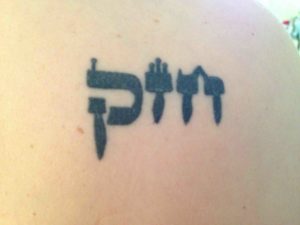 This is a guest post by Anita Diamant. It originally appeared on her blog, Mother Daughter Mashup. It is reprinted here with permission. Anita will be the scholar in residence at Shir Tikvah in Minneapolis, September 27-28, 2013.
This is a guest post by Anita Diamant. It originally appeared on her blog, Mother Daughter Mashup. It is reprinted here with permission. Anita will be the scholar in residence at Shir Tikvah in Minneapolis, September 27-28, 2013.
Emilia was a precocious kid. When she about 8 years old we were sitting on a park bench people-watching, when a teenager wearing a belly-button ring passed by. She said, “You won’t have to worry about that.”
“No belly button piercing?” I asked.
“Silly Mommy.”
“No tattoos?”
“No,” she said and rolled her blue eyes.
You know where this is going. My daughter is 27 years old, and while she has no ring in her navel and has removed the industrial piercing through the cartilage in her right ear, she does have a tattoo.
Jews are not supposed to get tattoos. It’s in the Torah, Leviticus 19: 28. “You shall not make gashes in your flesh for the dead, or incise any marks on yourselves” followed by the words, “I am the Lord,” so you know this rule comes from the top.
The Torah also tells us that picking up bread on the Sabbath and sassing our elders are punishable offences.
In the aftermath of the Nazi holocaust, it seemed that tattooing would be forever associated with numbers burned into the flesh of concentration camp slaves – a mutilation of body and soul.
But those tattoos are no longer a primary point of reference for people under the age of 40. According to a 2007 poll of 1,500 people conducted by the Pew Research Center, 36 percent of 18- to 25-year-olds and 40 percent of 26- to 40-year-olds have at least one tattoo. I haven’t seen a survey of Jewish 18-40 year-olds, and while the figure might be lower, it’s probably pretty close.
Tattoos on Jews include flowers and butterflies. But if you Google “Jews and Tattoos,” you’ll see stars of David, as well as Hamsas (a hand meant to ward off the evil eye), dancing rabbis, and one famous “Kosher pig.” A friend spotted a full-color diagram of the Kabalistic sepherot (mystical spheres) inked on an upper arm.
 My daughter’s tattoo is on her shoulder blade; three Hebrew letters that spell out Chet, Zayin, Kuf, which spells chazak and means “strength.”
My daughter’s tattoo is on her shoulder blade; three Hebrew letters that spell out Chet, Zayin, Kuf, which spells chazak and means “strength.”
She told me she was going to get that very tattoo when she was fifteen years old and returned from a semester-long high school program Israel. Ten years later, she did it.
Emilia says, “It’s the word used when you finish reading one book of Torah and go to the next. It reminds me that we go from one thing to the next in strength. Israel was a time of transition for me, and I feel like it reinforces that message of strength that is inside me forever and ever.
“It’s also about a sense of pride, a display of who I am that you might not be able to tell by just looking at me.”
Emilia’s tattoo makes me feel … wistful.
When she was four months old, I discovered a scratch across the bridge of her nose. It might have come from a toy or her own fingernail. It was nothing and it
healed quickly, leaving the faintest of scars, invisible to everyone but me. But to me, it was a reminder of her vulnerability and my inability to protect her against the inevitable wear and tear of life. An early lesson in letting go of what wasn’t mine to keep.
Chazak, Emilia!
Anita Diamant is an American author of fiction and non-fiction books. She is best known for her novel, The Red Tent, a New York Times best seller.

